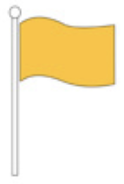Ocean Safety & Rip Current Awareness
Condition Flags
Color coded condition flags can be seen on each lifeguard stand to advise beach patrons of the current water conditions. Be sure to check the conditions when coming to Wrightsville Beach and if you have any questions, ask a lifeguard!
Yellow flags indicate a medium hazard. Moderate surf and/or currents are present. Weak swimmers are discouraged from entering the water and enhanced care and caution should be exercised.
Red condition flags indicate a high hazard. Rough conditions such as strong surf and/or currents are present. All swimmers are discouraged from entering the water. Those entering the water should take great care. Wind and/or wave conditions are expected to support the development of very strong rip currents. This category implies that water conditions are life threatening to all people who enter the surf. There may be a high number of rescues on red flag days.
At particular lifeguard stands (1, 2, 3, 4, 7, 8, 9, 10, 11, 12, 13, 14) you will see 1-2 checkered flags. These flags indicate “surf zones”- where the surfers are NOT permitted to surf. There is no surfing tolerated in between checkered flags, this ensures a safer area for beach patrons in the water. The flags will go up and down when the lifeguard reports and leaves from the stand, typically 10am-5pm. Holiday weekends and busier times in the season may alter these hours. When red flags are flying, there will be no surf zone enforced.
Break the Grip of the Rip
Break the Grip of the Rip
Each Summer, Wrightsville Beach lifeguards make approximately 200-400 rescues (Memorial Day to Labor Day).
Facts about rip currents
-
Rip currents are powerful, narrow channels of water that moves away from the beach. These channels can move up to 8 feet per second, faster than an Olympic swimmer.
-
Rip currents can be dangerous when swimmers panic and attempt to swim against the current. This quickly tires the swimmer and the drowning process begins.
-
First, always swim near a lifeguard. Lifeguards are trained to spot rip currents. Please see the above video and note the discoloration in the water. The dark channel of water is moving away from the coastline, that is a rip current.
-
MOST IMPORTANTLY: DO NOT PANIC. Most rip currents will only pull a swimmer out several yards before dissipating. Swim parallel to shore (with the longshore current) until you are out of the rip current, then slowly swim to shore. If you witness someone caught in a rip current, call 911.
Drone footage of a rip current forming just south of Crystal Pier. Notice the difference in water color and direction the cloudy water is flowing.









